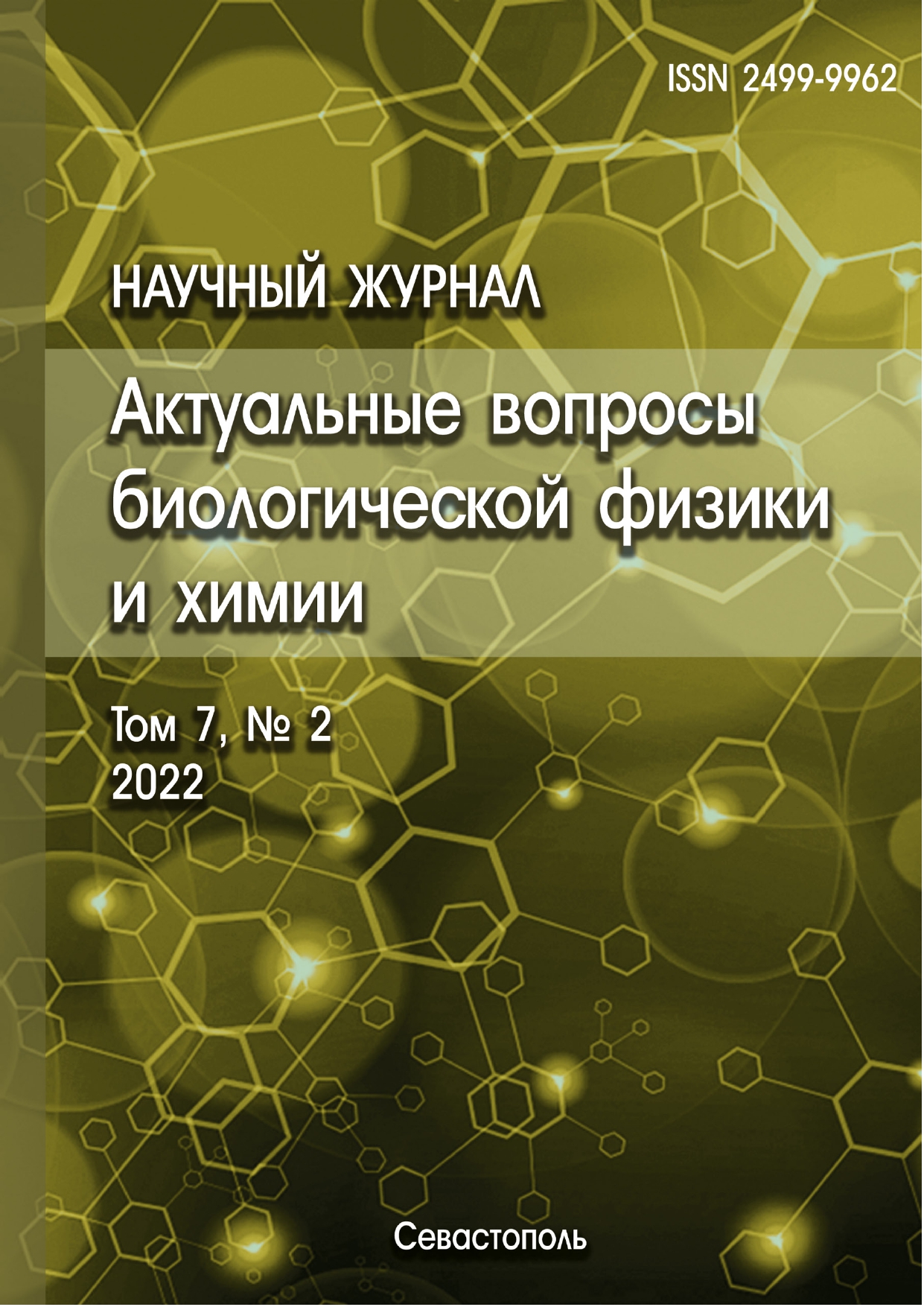Sarov, Nizhny Novgorod, Russian Federation
Sarov, Nizhny Novgorod, Russian Federation
Sarov, Nizhny Novgorod, Russian Federation
Sarov, Nizhny Novgorod, Russian Federation
The article presents the comparative study results of the bioeffects of 30-minute exposure session to electromagnetic radiation with 1000 MHz frequency and 10 mW/cm2 EFD; of 30-minute exposure session to low-frequency pulsed magnetic field with 4 mT magnetic induction, as well as their combination, on rat’s lymphocytes apoptosis level in vivo. The apoptosis level was assessed morphologically with fluorescent microscope after 24-hours of cell suspension cultivation at immunological plates at 37 0C in nutrient medium without loading. The percentage of cells with morphological signs of apoptosis (margination, condensation and fragmentation of chromatin in nucleus) was quantitatively determined. It was found that electromagnetic irradiation had no significant impact on apoptosis level, but magnetic field action resulted in reducing the apoptosis cells number by 16% (p≤0,01) compared to the control group. The combination of electromagnetic radiation and low intensity magnetic field increased the apoptotic cells number by 28% (p ≤0.01) compared to the control. Thus, the mediated effect of electromagnetic radiation on blood cells genome leads to disruption of its normal functioning. It has been shown that low-frequency magnetic field can influence on intracellular processes in different directions; in combination with electromagnetic radiation it can intensify pathological reactions, and thus launching the apoptosis massive program.
electromagnetic radiation, pulsed magnetic field, lymphocytes, apoptosis
1. Grigoriev Yu.G. Mobile communications and electromagnetic chaos in assessing the danger to public health. Who is responsible? Radiation biology. Radioecology, 2018, vol. 58, no. 6, pp. 633-645. (In Russ.) DOI: https://doi.org/10.1134/S086980311806005X; EDN: https://elibrary.ru/YQCVDF
2. Akhiezer A.I., Akhiezer I.A. Electromagnetism and electromagnetic waves. Textbook for universities. M.: Higher school, 1985, 504 p. (In Russ.)
3. Kudryashov Yu.B., Perov S.Yu., Rubin A.B. Radiation biophysics: radiofrequency and microwave electromagnetic radiation. Textbook. M.: publishing house Phismatlit, 2008, 184 p. (In Russ.) EDN: https://elibrary.ru/MUWSOX
4. Kulikov A.G., Voronina D.D. Possibilities of general magnetic therapy in treatment and rehabilitation (review). Issues of balneology, physiotherapy and exercise therapy, 2016, vol. 93, no. 2, pp. 48-52. (In Russ.) EDN: https://elibrary.ru/VTILIR
5. Ushakov I.B. Combined impacts in human ecology and extreme medicine. M.: Izdattsentr, 2003, 442 p. (In Russ.) EDN: https://elibrary.ru/JLBRWX
6. Model sample of the hardware-software complex "Buton". Trademark certificate No. 386501 dated 03.12.2007. Patent RU 2290970 C2 dated March 28, 2005. Patent RU 159809 U1 dated 06.16.2015. (In Russ.)
7. Skibo Yu.V., Abramova Z.I. Methods for the study of programmed cell death. Educational and methodological manual for masters in the course "Theory of apoptosis". Kazan: FGAOU VPO KFU, 2011, 61 p. (In Russ.)
8. Karpishchenko A.I. Medical laboratory technologies: a guide to clinical laboratory diagnostics. M.: GEOTAR-Media, 2013, 792 p. (In Russ.)
9. Svirnovsky A.I., Sheleg S.V. Methods for assessing the structural and functional state of peripheral blood lymphocytes. Guidelines. Ministry of Health Rep. Belarus, 2000, reg. no. 173-0012. (In Russ.)
10. Lapach S.N., Chubenko A.V., Babich P.N. Statistical methods in biomedical research using Excel. Kiev: Morion, 2000, 319 p. (In Russ.)
11. Glantz S.M. Medico-biological statistics: practice. M.: Nauka, 1999, 459 p. (In Russ.)
12. Graziano M.J. Induction of apoptosis in rat peripheral blood lymphocytes by the anticancer drug CI-994 (acetyldinaline). J. Biomed. Biotechnol., 2001, no. 1, pp. 52-61. DOI: https://doi.org/10.1155/S1110724301000146; EDN: https://elibrary.ru/XUJCBB
13. Gorman A., McCarthy J., Finucane D. et al. Morphological assessment of apoptosis. In: Techniques in apoptosis. A user’s guide. Cotter T.G. and Martin S.J. Portland Press, 1994, pp. 1-20.
14. Belkin A.D. The content of proteins-regulators of apoptosis bcl-2 and bad in the regional lymph nodes of the liver under the influence of a magnetic field of 50 Hz. Hygiene and Sanitation, 2015, no. 1, pp. 112-114. (In Russ.) EDN: https://elibrary.ru/TSBQPZ
15. Tiras Kh.P., Skavulyak A.N., Aslandini K.B., Ivanitsky G.R. Why are the effects of weak combined magnetic fields on biosystems not always reproducible? DAN, 2012, vol. 443, no. 6, pp. 1-3. (In Russ.)
16. Ivashkin V.T., Lapina T.L., Bondarenko O.Yu., Bueverov A.O., Osadchuk A.M., Kogan E.A. et al. Processes apoptoza I proliferation pathology gastrointestinaland live. Rossiyskiy Zhurnal Gastroenterologii, Gepatologii, Koloproktologii, 2002, no. 6, pp. 38-43. EDN: https://elibrary.ru/RSVMLP
17. Aruin L.I. Apoptosis in pathological processes in the digestive organs. Clinical medicine, 2000, vol. 1, pp. 5-10. (In Russ.)
18. Rajendra P., Sujatha H.N., Sashidhar R.B., Subramanyam C., Devondranath D., Aradhya R.S. Viability of unstimulated lymphocytes exposed to extremely low frequency electromagnetic fields is dependent on intensity. BioDiscovery, 2012, vol. 2, p. e8925, doi:https://doi.org/10.7750/BioDiscovery.2012.2.2.
19. Plekhanov G.B. Basic regularities of low-frequency electromagnetobiology. Tomsk: publishing house of Tomsk University, 1990, 188 p. (In Russ.)
20. Rybakov Yu.L. Antitumor and radiomodifying effect of a weak low-frequency vortex magnetic field. Radiation ecology. Radioecology, 2016, vol. 56, no. 2, pp. 177-189. (In Russ.) DOI: https://doi.org/10.7868/S0869803116020107; EDN: https://elibrary.ru/VVHLPJ
21. Kolomiets I.A. Adaptive responses of mammalian blood cells to the impact of electromagnetic fields of the radio frequency range. Diss. cand. biol. Sciences, Chelyabinsk, 2009, 23 p. (In Russ.) EDN: https://elibrary.ru/QEGOXL










